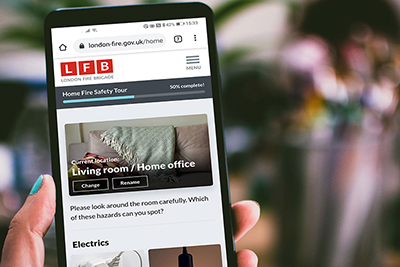Understanding and reducing the risks
What do we mean by emollient and skin creams?
Emollient and skin creams are an important and effective treatment used to prevent or treat dry skin conditions like:
- Eczema
- Bed sores
- Ulcers
- Psoriasis
They come in a variety of forms: creams, lotions, ointments, gels or sprays . They can also include soap alternatives. They may be water-based, contain paraffin or natural oils. All cover the skin with a protective film to reduce water loss.
Emollient/skin cream residue on fabrics such as bedding, clothing and dressings can increase flammability, even from just one application. Emollients and skin creams are especially a fire safety concern when used by people who spend extended periods in a bed or armchair due to illness or impaired mobility.
How can you use emollient and skin creams more safely?
If you care for someone who needs emollient and skin creams, lotions or gels, or if you use these products yourself, you can help to keep them and yourself safe by understanding and reducing the related risks.
Understand the risks
Anyone using emollients or skin creams regularly should keep well away from fire, naked flames or heat sources. A build up of residue on bedding, clothing and dressings can increase flammability.
- Don't smoke
- Loose clothing can easily catch fire – take care not to lean over a hot hob and roll up your sleeves if possible when cooking.
- Keep candles away from your clothing, including when lighting them.
- Sit at least one metre away from a heater – sitting too close could easily set light to your clothes or chair. Always follow the manufacturer’s instructions.
There is a separate page for healthcare equipment including oxygen therapy, dynamic airflow pressure relieving mattresses and incontinence products– and there is specialist advice to support you if you care for a person who is a smoker, or someone who has hoarding disorder.
Getting extra help
Get expert advice with a home fire safety visit
We can provide more specialist advice based on your home and individual needs, or the home and individual needs of the person you care for, during a home fire safety visit.
Visits can be arranged at any time (24/7), and we even fit free smoke alarms if you or the person you care for needs them. Specialist alarms can also be fitted – for example, strobe light and vibrating pad alarms for those who are deaf or hard of hearing.

Worried about someone you care for?
We have a simple tool that can guide you around the home helping you spot fire risks, or we can carry out a visit ourselves.
Extra information for formal and informal carers, support workers and other health care professionals
Carers, support workers and other health care professionals have access on a daily basis to people’s homes and living spaces. They play a vital role in the assessment of high risk individuals.
- If you are a formal carer, support worker or other healthcare professional, record and report your concerns to your line manager so an action plan can be put into place.
- If you are an informal carer, reduce any risks that you are able to, and notify other agencies such as Social Services to enable them to take swift and appropriate action as required.
- Use our online resources such as the Home Fire Safety Checker, or download the Checklist for Person Centred Fire Risk at the bottom of this page – this will help you identify areas of risk to the person you care for. You can also contact us to request an in-person Home Fire Safety Visit.
- If the person you care for or support is also in receipt of other care, or other agencies are also involved with them, do share your concerns so that you are all working together. Make sure that fire risk is included in the person’s care plan including things like using flame retardant bedding, appropriate management of emollient and skin creams, and how to care for people who smoke.
- Communicate with the person’s family or other supporting agencies to consider how Telecare can help to keep vulnerable people safer.
- Consider training to help you spot signs that may indicate the person you care for is at risk of injury from fire – and learn what steps you can take to reduce those risks.
Consider limited mobility
If the person you care for is bed bound or spends most of their time in a chair, they are particularly at risk. Please consider their needs and make sure appropriate measures are taken so they can safely escape if there is a fire. Learn more about escape plans from homes, and escape from workplaces (like residential care homes).
